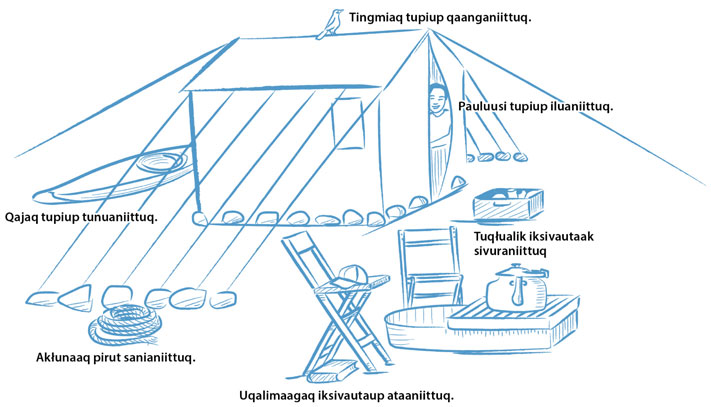Roots
There are a series of roots that can be used to describe the positioning of a person or object in relation to someone or something else. These roots vary from dialect to dialect.
| sani– | beside |
| quli- / qulaa- | above |
| qaa– | on top of |
| ati– / ataa– | under |
| sivuraa– | in front of an object |
| saa– | at the front of |
| ungati- / -ungataa | on the far side of; past; beyond |
| tunu– | at the back of |
| ilu– | inside of |
Endings
The roots above can be used to describe the space around a person or an object using a possessive noun ending:
| in/at/on | from | to |
| saninni beside me |
saninnit from the space beside me |
saninnut to the space beside me |
| saningni beside you |
saningnit from the space beside me |
saningnut to the space beside you |
| saniani beside him/her/it |
sanianit from the space beside him/her/it |
sanianut to the space beside him/her/it |
| sanittinni beside us |
sanittinnit from the space beside us |
sanittinnut to the space beside us |
| sanissingni beside you (2+) |
sanissingnit from the space beside you (2+) |
sanissingnut to the space beside you (2+) |
| saniani beside them |
sanianit from the space beside them them |
sanianut to the space beside them |
Some of these roots have a form that ends in -i before first and second person and a form that ends in -aa in the third person:
| atinni | underneath me |
| atingni | underneath you |
| ataani | underneath him/her/it/them |
These nouns can be used to describe where something is happening:
Saninni iksivaaqtuq.
He/she is sitting beside me.
Saali tunungnut ijiqtuq.
Charlie hid behind you.
Qimmit saattinnit miagguuqtut tusaqsaujut.
You can hear the dogs howling from the front of our house.
Positions and verb affixes
It is also possible to add a verb affix to the position names.
–niit– (to be in/at/on)
saninniittuq
It is beside me.
tunungniittuuk
The two of them are behind you.
qulaaniittut
They are above her.
saanniittuq
It is in front of me.
qaanganniittut
They are on top of it.
iluanniituuk
The two of them are inside it.
–nuaq– (to go towards)
qulaanuaqtuq
He/she went upstairs.
tunungnuaqtut
They (3+) went behind you.
saattinnuaqtuuk
The two of them went in front of us.
–ninngaaq– (to come from)
qulinninngaaqtuq
It came from above me.
tunungninngaaqtut
They came from behind you.
Naming the person or object
If the person or object that is the reference point is named and is
singular (there is only one of them), that word takes the ending –up:

qaa–
on top of
qaanganiittuq
It is on top of it.
Tingmiaq tupiup qaanganiittuq.
The bird is on top of the tent.
ataa–
underneath
ataaniittuq
It is under it.
Kipuup ataaniittuq.
It is undeneath the table.
If the people or objects that are the reference point are in the dual or
plural, the word does not take the –up ending.
Tingmiat qajaup qaanganiittut.
The birds are on top of the kayak.
Umiirijjutit umiat ataaniittut.
The rollers are under the boats.
Tingmiat qajat qaanganiittut.
The birds are on top of the kayaks.